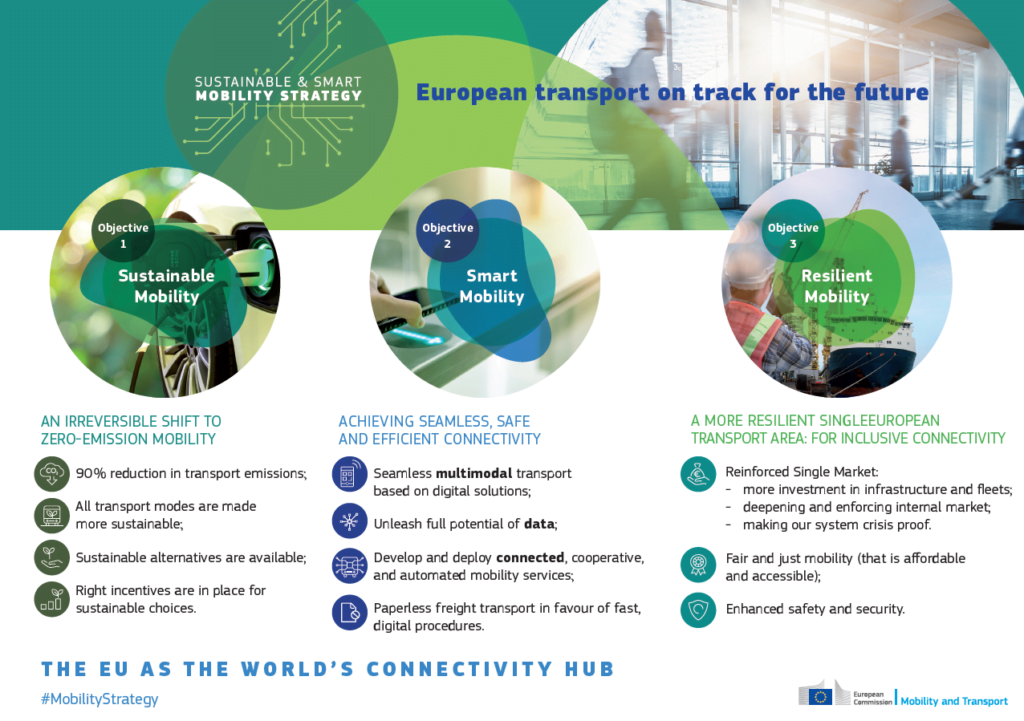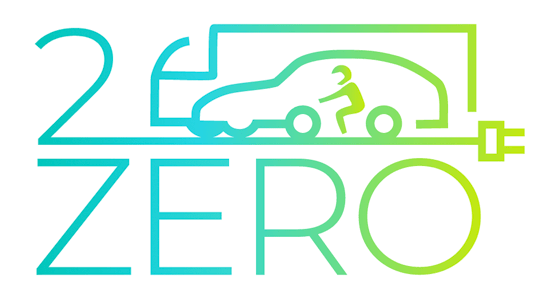Sustainable and Smart Mobility Strategy – European transport on track for the future

The new Sustainable and Smart Mobility Strategy has now been adopted. The Strategy sets out the EU vision for the transport system of the future and the action plan that will make it happen.
What are the key elements of this Strategy?
The Sustainable and Smart Mobility Strategy is structured around three key objectives: making the European transport system
- Sustainable mobility: involving an irreversible shift to zero-emission mobility by making all transport modes more sustainable, ensuring wide availability of the most sustainable options and giving users incentives to make sustainable choices;
- Smart mobility: supporting sustainable choices by taking advantage of digitalisation and automation to achieve seamless, safe and efficient connectivity;
- Resilient mobility: bouncing back from the COVID-19 pandemic by creating a Single European Transport Area that is affordable and accessible for all citizens and businesses and resilient against future crises and safety and security challenges.
A clear path is needed to achieve a 90% reduction in transport-related greenhouse gas emissions by 2050. This is the effort required from transport to ensure the EU becomes the first climate-neutral continent by 2050, as outlined in the European Green Deal. Digitalisation will become an indispensable driver for the modernisation of the entire system, making it seamless and more efficient, while further reducing emissions. In addition, the coronavirus pandemic has shed light on the vulnerabilities of the single market and the need to strengthen its resilience.
The transition to a greener, smarter and more resilient mobility system should leave nobody behind. Mobility must be available and affordable for all, rural and remote regions must remain connected, and European transport must offer good social
conditions to its workers and provide attractive jobs.
The strategy sets out an action plan of concrete policy measures, structured around 10 key areas for action (“flagships”) areas that will guide the Commission’s work in the years to come. It also sets out milestones that show where we want to be in 10 and 30 years from now.
Why is this strategy necessary?
While mobility offers its users many benefits, it is not without costs for our society. Negative effects such as greenhouse gas emissions, air and water pollution, but also accidents and road crashes, congestion, noise, and biodiversity loss affect our health and wellbeing. Past efforts have not yet addressed these costs sufficiently. Today, transport accounts for a quarter of the EU’s total greenhouse gas emissions and emissions have increased over recent years. Our goal of being the first climate-neutral continent by 2050 and our -55% greenhouse gas emissions reduction target by 2030 requires more ambition in transport.
Europe also needs to use digitalisation and automation to further increase levels of safety, security, efficiency, reliability, and comfort, thereby maintaining the EU’s leadership in transport equipment manufacturing and services, and improving our global competitiveness. Transport was among the sectors hit hardest by the coronavirus pandemic and the crisis has caused healthy companies to lose jobs and revenue. The strategy sets out much- needed reforms, policies and actions to support the sector in its recovery.

What milestones does the strategy set for 2030, 2035 and 2050?
Various milestones show the path to achieving our objectives of sustainable, smart and resilient mobility (in the road transport environment), such as:
By 2030:
– at least 30 million zero-emission cars will be in operation on European roads
– 100 European cities will be climate neutral.
– scheduled collective travel for journeys under 500 km should be carbon neutral
– automated mobility will be deployed at large scale
By 2050:
– nearly all cars, vans, buses as well as new heavy-duty vehicles will be zero-
emission.
– a fully operational, multimodal Trans-European Transport Network (TEN-T) for
sustainable and smart transport with high speed connectivity.
Find out more in the attached documents below and the website of the Strategy.
